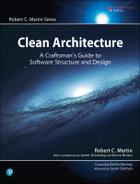26
THE MAIN COMPONENT

In every system, there is at least one component that creates, coordinates, and oversees the others. I call this component Main.
THE ULTIMATE DETAIL
The Main component is the ultimate detail—the lowest-level policy. It is the initial entry point of the system. Nothing, other than the operating system, depends on it. Its job is to create all the Factories, Strategies, and other global facilities, and then hand control over to the high-level abstract portions of the system.
It is in this Main component that dependencies should be injected by a Dependency Injection framework. Once they are injected into Main, Main should distribute those dependencies normally, without using the framework.
Think of Main as the dirtiest of all the dirty components.
Consider the following Main component from a recent version of Hunt the Wumpus. Notice how it loads up all the strings that we don’t want the main body of the code to know about.
public class Main implements HtwMessageReceiver {
private static HuntTheWumpus game;
private static int hitPoints = 10;
private static final List<String> caverns = new ArrayList<>();
private static final String[] environments = new String[]{
"bright",
"humid",
"dry",
"creepy",
"ugly",
"foggy",
"hot",
"cold",
"drafty",
"dreadful"
};
private static final String[] shapes = new String[] {
"round",
"square",
"oval",
"irregular",
"long",
"craggy",
"rough",
"tall",
"narrow"
};
private static final String[] cavernTypes = new String[] {
"cavern",
"room",
"chamber",
"catacomb",
"crevasse",
"cell",
"tunnel",
"passageway",
"hall",
"expanse"
};
private static final String[] adornments = new String[] {
"smelling of sulfur",
"with engravings on the walls",
"with a bumpy floor",
"",
"littered with garbage",
"spattered with guano",
"with piles of Wumpus droppings",
"with bones scattered around",
"with a corpse on the floor",
"that seems to vibrate",
"that feels stuffy",
"that fills you with dread"
};
Now here’s the main function. Notice how it uses the HtwFactory to create the game. It passes in the name of the class, htw.game.HuntTheWumpusFacade, because that class is even dirtier than Main. This prevents changes in that class from causing Main to recompile/redeploy.
public static void main(String[] args) throws IOException {
game = HtwFactory.makeGame("htw.game.HuntTheWumpusFacade",
new Main());
createMap();
BufferedReader br =
new BufferedReader(new InputStreamReader(System.in));
game.makeRestCommand().execute();
while (true) {
System.out.println(game.getPlayerCavern());
System.out.println("Health: " + hitPoints + " arrows: " +
game.getQuiver());
HuntTheWumpus.Command c = game.makeRestCommand();
System.out.println(">");
String command = br.readLine();
if (command.equalsIgnoreCase("e"))
c = game.makeMoveCommand(EAST);
else if (command.equalsIgnoreCase("w"))
c = game.makeMoveCommand(WEST);
else if (command.equalsIgnoreCase("n"))
c = game.makeMoveCommand(NORTH);
else if (command.equalsIgnoreCase("s"))
c = game.makeMoveCommand(SOUTH);
else if (command.equalsIgnoreCase("r"))
c = game.makeRestCommand();
else if (command.equalsIgnoreCase("sw"))
c = game.makeShootCommand(WEST);
else if (command.equalsIgnoreCase("se"))
c = game.makeShootCommand(EAST);
else if (command.equalsIgnoreCase("sn"))
c = game.makeShootCommand(NORTH);
else if (command.equalsIgnoreCase("ss"))
c = game.makeShootCommand(SOUTH);
else if (command.equalsIgnoreCase("q"))
return;
c.execute();
}
}
Notice also that main creates the input stream and contains the main loop of the game, interpreting the simple input commands, but then defers all processing to other, higher-level components.
Finally, notice that main creates the map.
private static void createMap() {
int nCaverns = (int) (Math.random() * 30.0 + 10.0);
while (nCaverns-- > 0)
caverns.add(makeName());
for (String cavern : caverns) {
maybeConnectCavern(cavern, NORTH);
maybeConnectCavern(cavern, SOUTH);
maybeConnectCavern(cavern, EAST);
maybeConnectCavern(cavern, WEST);
}
String playerCavern = anyCavern();
game.setPlayerCavern(playerCavern);
game.setWumpusCavern(anyOther(playerCavern));
game.addBatCavern(anyOther(playerCavern));
game.addBatCavern(anyOther(playerCavern));
game.addBatCavern(anyOther(playerCavern));
game.addPitCavern(anyOther(playerCavern));
game.addPitCavern(anyOther(playerCavern));
game.addPitCavern(anyOther(playerCavern));
game.setQuiver(5);
}
// much code removed…
}
The point is that Main is a dirty low-level module in the outermost circle of the clean architecture. It loads everything up for the high level system, and then hands control over to it.
CONCLUSION
Think of Main as a plugin to the application—a plugin that sets up the initial conditions and configurations, gathers all the outside resources, and then hands control over to the high-level policy of the application. Since it is a plugin, it is possible to have many Main components, one for each configuration of your application.
For example, you could have a Main plugin for Dev, another for Test, and yet another for Production. You could also have a Main plugin for each country you deploy to, or each jurisdiction, or each customer.
When you think about Main as a plugin component, sitting behind an architectural boundary, the problem of configuration becomes a lot easier to solve.
